Research to Inform the Five Year Review of the Home Report
Conducted to inform the five-year review of the Home Report. This research followed on from, and was informed by, the Home Report public consultation launched on 5 December 2013. The research study was conducted by Ipsos MORI and Retties and Co. and examined how the Home Report has performed over the past 5 years.
4 Operation of the Home report
4.1 This section considers in-depth the attitudes of consumers, industry professionals and stakeholders to the Home Report, looking at perceptions of the content of the Home Report generally before looking at each element of the report in more detail. It then goes on to look at the prevailing market conditions in Scotland since the Home Report was introduced.
Contents of the Home Report
General perceptions among buyers and sellers
4.2 In general, buyers and sellers tended to be positive about the content of the Home Report. Around three quarters of buyers (74%) said that the information contained within the Home Report was helpful (Figure 4.1). That said, ratings of helpfulness had gone down since the Interim Review (81% of buyers reported that the Home Report was helpful in the Interim Review, compared with 74% in the year 5 review).
Figure 4.1 Overall helpfulness
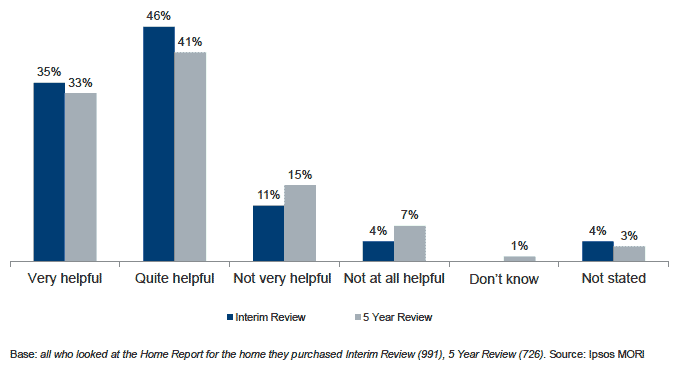
4.3 The perceived usefulness of information in the Home Report was closely related to the value of the property being bought and the age and experience of the buyer.
4.4 Over a third (35%) of those buying properties worth £300,000 or less thought that the information was 'very useful.' This fell to 22% among those buying more expensive homes.
4.5 Feedback from the focus group with estate agents suggested that lenders are less likely to accept valuations from the Home Report on expensive property. Therefore, those buying these properties were more likely to be asked to commission their own generic mortgage valuation report (GMVR). This could provide one explanation why levels of satisfaction with the Home Report differ by property price.
4.6 Less experienced buyers were the most positive about the Home Report - 90% of first-time buyers said that information in the Home Report was 'helpful', compared with 67% of more experienced buyers.
4.7 In addition, younger home buyers thought the Home Report was more helpful than older home buyers (Table 4.1).
Table 4.1 Proportion of buyers who said that information contained within the Home Report was helpful by age
| Age | % |
|---|---|
| 16-34 | 88% |
| 35-54 | 77% |
| 55-64 | 64% |
| 65+ | 57% |
Base: buyers who had looked at a Home Report for the property they purchased (726) 5 Year Review. Source: Ipsos MORI.
4.8 The majority of both buyers and sellers thought that the Home Report contained the right amount of information. However, as with the perceived usefulness of information in the Home Report, views differed by property purchase price and the experience of the buyer.
4.9 Among first-time buyers, 70% thought the Home Report contained the right amount of information, compared with 50% of more experienced buyers.
4.10 There were also differences according to property price: 63% of those buying a home up to £120,000 thought that the amount of information was the right amount, compared to 47% of those paying over £300,000. Furthermore, those buying more expensive properties were more likely to think that there was not enough information than those buying a home up to £120,000 (33% and 21%, respectively).
4.11 Buyers were much more likely than sellers to think that the Home Report did not contain 'enough information'. A quarter of buyers (25%) thought this, compared to 11% of sellers (Figure 4.2).
Figure 4.2 Amount of information
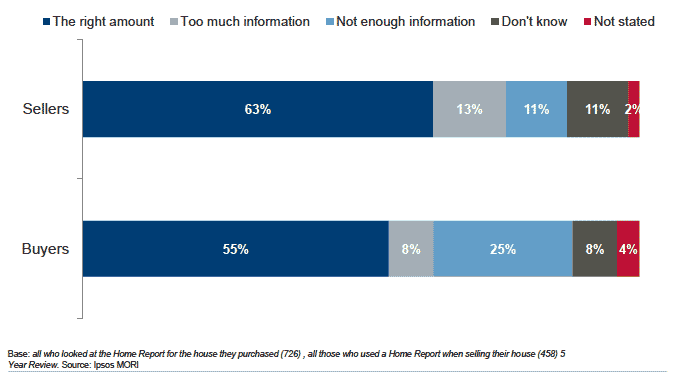
4.12 There was a clear difference in attitudes towards the single survey and the valuation[9] on one hand, and the energy report and the property questionnaire on the other, both in terms of helpfulness and impact on decision to buy a property. Table 4.2 shows that over three quarters found the single survey (76%) and valuation (81%) to be useful, compared to under two-thirds who felt the same about the property questionnaire and energy report (both 63%).
Table 4.2 Helpfulness and impact on decision making
| Home Report component | % information was helpful | % information affected decision to buy property |
|---|---|---|
| Single survey | 76 | 52 |
| Valuation | 81 | 59 |
| Property questionnaire | 63 | 31 |
| Energy report | 63 | 25 |
Base: buyers who had looked at a Home Report for the property they purchased (726) 5 Year Review. Source: Ipsos MORI.
4.13 Buyers' views of reliability were fairly consistent across all components (Figure 4.3). However, as with the perceived helpfulness of the Home Report overall, reliability scores for the single survey and the valuation report have fallen between the Interim Review and now. (74% to 63% for the single survey and 76% to 66% for the valuation report).
4.14 Perceptions of usefulness and reliability were linked. Buyers who thought that the Home Report was reliable were more likely to say it was helpful and vice versa. However, we cannot say for certain which measure drives the other.
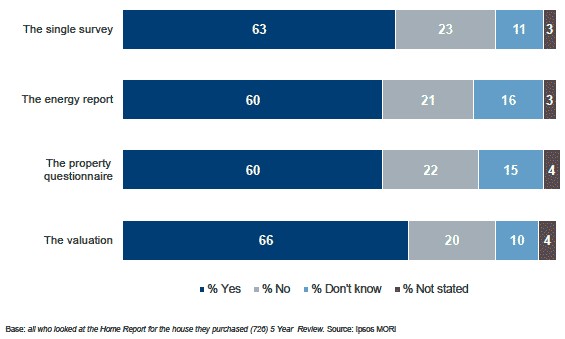
4.15 The findings from the qualitative interviews with buyers and sellers suggest that it is the reliability of the Home Report that can sometimes lead to dissatisfaction. The main concern that buyers had with the Home Report was that repairs/problems with the property were not identified - a number of the buyers in the qualitative research were able to give specific examples of this happening.
4.16 These issues tended to be those that may not be caught in a visual inspection, with no subfloor or roof access. Therefore, it is difficult to conclude whether these reflect genuine issues with the reliability and quality of the Home Report being completed or, rather, reflect the limitations of the inspection due to access restriction, no testing of heating systems or electrics and that no furniture can be moved, something which can be misunderstood by buyers.
4.17 The survey findings highlight the areas where some buyers want more information. Those who thought the Home Report contained too much or too little information would like to see 'more detailed/comprehensive information regarding condition of property in the single survey' (20%) and 'more comprehensive/in depth information in general' (12%).
4.18 Furthermore, the majority of buyers (61%) would have liked the opportunity to speak to the surveyor who inspected the property, again suggesting the buyers were looking for more information. However, in practice less than half (44%) actually sought any advice about the content of the Home Report.
General perceptions among industry professionals and stakeholders
4.19 Views on the content of the Home Report were more critical among industry professionals, particularly those based in Edinburgh and Glasgow, than among buyers and sellers. National stakeholders were less critical than those on the 'front-line' of the industry but still focused on aspects that required improvement.
4.20 Specific issues with each component are covered in more detail in the following sections, but the overarching issue that professionals and stakeholders consistently raised was that the Home Report is too long and buyers only use a very small part of it.
4.21 At the moment, the Home Report is unlikely to be shorter than 40 pages and can sometimes be significantly longer, which professionals thought made them daunting to read and understand. This is exacerbated by the fact that the report starts with at least 5-6 pages of terms and conditions before considering the property in question.
4.22 This leads to a dilemma for the future design of the Home Report. On the one hand it is important for consumers to receive sufficient detail to avoid the misunderstandings outlined earlier but, on the other hand, professionals and stakeholders think that too much information can discourage buyers from reading it.
4.23 The feedback from industry professionals suggests that the Home Report in its current form discourages consumers from reading it, despite the scale, and importance, of the purchase involved. Professionals said that the majority of buyers were only interested in the summary of the repair categories and the valuation report.
"From our own feedback, people tend to have a quick squint at the condition report, the valuation and how long it's been on the market…then that's them."
Solicitor Property Centre
Overall views of the single survey
4.24 The single survey was the most frequently discussed, and considered to be the most important, part of the Home Report, particularly the repair categories. This is likely to be because of a consensus among consumers and professionals that the single survey contains the information that consumers are looking for, and answers the essential question for buyers - 'is there anything wrong with this property?' Among buyers who reported that they had discarded a property based on the Home Report, 85% said that it was the single survey that helped them make this decision, a greater proportion than mentioned any other component of the Home Report (Figure 4.4).
Figure 4.4 Which element(s) of the Home Report helped you decide to discard the property?
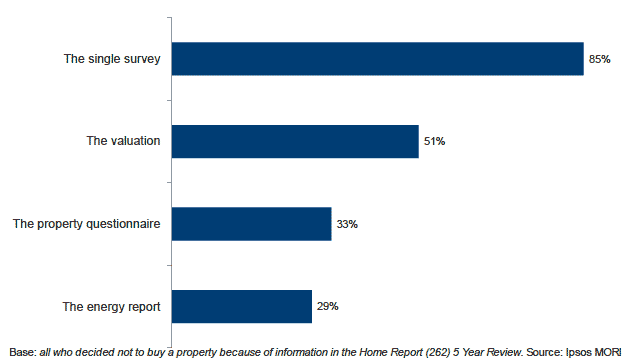
4.25 Among all audiences, the 'neutral, bland' language was the main criticism of the single survey, frequently interpreted by buyers and sellers as a lack of detail. Professionals and stakeholders saw this as particularly problematic as they felt the document was too long despite its perceived lack of depth.
4.26 A surveyor is liable to both the seller who commissions the report and the buyer who purchases the property. A buyer can claim damages against a surveyor where they have suffered a material loss[10]. This means that the surveyor could potentially be liable for any subjective or speculative statements they make.
4.27 Furthermore, a number of both industry professionals and national stakeholders believed that buyers were increasingly trying to use the Home Report as a basis for launching legal proceedings against surveyors.
"It is starting, what we predicted. It's being used as a litigious document."
Surveyor group
4.28 Industry professionals acknowledged that to some extent, the neutral language was a result of the legislation, leading to a factual, objective inspection of the property. However, professionals (including surveyors) suggested that surveyors neutralised their language in order to protect themselves in case a buyer tried to use the Home Report to get compensation from them in the event of a subsequent problem.
4.29 The neutral language used meant that some surveyors felt limited by what they could write in the single survey report, despite the fact that this was self-imposed to some extent. While they believed that the inspection carried out was the equivalent of a Scheme Two survey, the resulting report did not reflect this work. This was because they felt that the neutral language did not allow them to express their full opinion of the property.
4.30 Estate agents and surveyors tended to think that this neutral language was most beneficial to sellers since it could downplay the severity of condition issues. Unsurprisingly then, in the qualitative research it was clear that, with one or two exceptions, sellers were more positive about the single survey that was carried out on the property they were selling than the one they subsequently purchased. When they could see the survey happening they were more satisfied with its thoroughness, lending some weight to the concerns of surveyors.
4.31 Other complaints about the report or single survey included:
- the use of jargon and technical language that some buyers and sellers found difficult to understand
- the use of the phrase "commensurate with the age of the property" without further context about what that means in practice in terms of repairs and maintenance for the owner, and
- extensive use of caveating - to the point where the commentary risked losing any substantive meaning.
4.32 While some industry professionals (including some surveyors) believed that buyers' misperceptions on the scope of the survey contributed to the neutral language of the single survey, others thought that the neutral language contributed to buyers' misperceptions suggesting that there was a cyclical relationship between the two issues.
4.33 While the repair categories were thought by most buyers and sellers to be 'very useful', and one of the few aspects of the Home Report that was consistently scrutinised by buyers, this was an area where professionals had concerns about a conflict of interest between the seller, the surveyor and the buyer. The seller wants a report that minimises any mention of required repairs, category 3 repairs in particular. In contrast, the buyer wants the report to highlight any problems associated with the property. This has two potentially problematic consequences.
4.34 First, professionals reported that they knew of instances where selling agents (and, to a lesser degree, sellers themselves) had applied pressure on surveyors to change repair category ratings. This mostly consisted of agents asking surveyors to reconsider a category that they thought was open to interpretation or overly cautious. Selling agents saw asking for these changes as a fairly widespread and inevitable part of 'doing business'.
"[Surveyors are] not going to tell lies and say there's not dry rot when there is but they're malleable on the categories"
Estate agent group
4.35 However, although thought to be far less widespread, professionals also raised the issues that existing business and financial relationships were being exploited to allow selling agents much greater influence over the contents of the single survey. In general, the professionals made reference to selling agents in the central belt when discussing this issue.
4.36 Second, it was also thought that this contributed to the use of beauty parades. 'Beauty parades' are the practice of engaging several surveyors to conduct a survey and/or a valuation report so that the one with the most flattering condition report can then be selected for use in marketing the property. While both selling agents and surveyors acknowledged that this still happens, they felt it was less prevalent than in the early stages of the Home Report.
Overall views of the valuation report
4.37 Most buyers and sellers thought that the valuation was reliable (66% of buyers and 71% of sellers). The qualitative research echoed this finding. It was common for both buyers and sellers to mention that the valuation report gave them confidence in the price at which they purchased/sold.
4.38 Professionals and lenders in particular, saw the valuation as an area in which the wider conflict of interest issue could play a role (see section 4.33). Buyers and sellers have opposing interest in the value of the property but the surveyor has a responsibility to both. The seller wants as high a price as possible, whereas the buyer wants as low a price as possible.
4.39 As with the repair categories professionals reported that pressure was sometimes placed upon surveyors to value in line with the selling agent's wishes and the use of beauty parades to get the value desired. However, this was thought to be mostly confined to the central belt.
Overall views of the property questionnaire
4.40 As highlighted in section 4.12, the property questionnaire was seen by buyers as less helpful and less likely to influence decision making than either the single survey or the valuation. This was reflected in the views of industry professionals who said that most buyers do not place much importance on the property questionnaire.
4.41 For the most part, buyers only look at small portions of the Home Report, the sections that they think are essential to know (i.e. how much does the property cost and is there anything wrong with it?), and the property questionnaire is not one of these sections. While some stakeholders suggested that much of the information is useful and interesting to a buyer, in practice, buyers do not tend to view it this way.
4.42 The contents of the property questionnaire were also criticised by housing industry professionals. Some questions were considered unnecessary (e.g. utility providers) while others were thought to repeat information collected by the surveyor (e.g. previous work carried out on the property). They also cited instances where the information in the single survey and property questionnaire contradicted each other.
4.43 Another criticism of the property questionnaire was that the form is not accurately completed by sellers. While, in some instances, this was simply due to a lack of knowledge on the seller's part, some professionals suggested that sellers may also be purposefully withholding information to improve the prospects of a sale. In some instances, such as repossessions, property questionnaires were left completely blank.
4.44 As buyers and professionals believed that sellers were often not completing property questionnaires fully or properly, there was a concern about the lack of accountability for the accuracy of the information included. A number of professionals felt that buyers should have a form of redress available if a seller was found to have submitted inaccurate information in the property questionnaire.
4.45 Despite these criticisms, some housing industry professionals thought the property questionnaire helped to speed up the conveyancing process by providing details of legal issues or at least highlighting areas which should be investigated in more detail.
Overall views of the energy report
4.46 While acknowledging that an Energy Performance Certificate (EPC) is a legal requirement when selling a property (outwith the remit of the Home Report), both industry professionals and the buyers/sellers saw the energy report as the least important and useful part of the Home Report.
4.47 As with the property questionnaire, the energy report is not part of the buyers' 'must know' information (see section 4.24). While it may be of interest, it is unlikely to affect a purchase decision either way in most cases.
4.48 Some national stakeholders felt that there was too much jargon in the energy report. In addition they felt that any key points, namely the energy efficiency rating, the estimated a4verage energy costs and recommended improvements were buried in superfluous information.
4.49 Some stakeholders also thought that changing the layout and presentation of the energy report could make it more relevant to buyers (e.g. having a summary upfront or incorporating some aspects into the single survey). However, the existing EPC legislation would need to be taken into careful consideration before making any changes.
4.50 There was a view from some professionals and stakeholders that although the energy report stimulates little interest now, this will change in the future. There were two reasons for this. First, the Scottish Government intends to consult in spring 2015 on proposals to set minimum standards of energy efficiency for existing private sector housing (the UK Government has recently consulted on proposals for the private rented sector only for England and Wales). Second, the rising cost of energy means that it will become increasingly important to make your home as energy efficient as possible.
Overall views of accessibility information
4.51 The accessibility information did not appear to be used by a large proportion of buyers. In the survey, most gave a neutral response when asked how helpful this information was, suggesting that it is not relevant to them (Figure 4.5).
Figure 4.5 Helpfulness of accessibility information among buyers
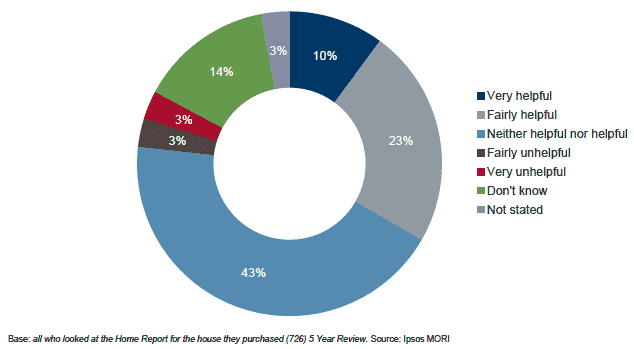
4.52 However, in the prospective buyers and sellers survey, 42% of prospective buyers did report that this information was important to them when making decisions about purchasing property (Figure 4.6). To some extent this will be due to the fact the respondent in the prospective buyers and sellers survey had an older profile, and therefore more likely to be interested in the accessibility information, than in the buyers and sellers survey.
Figure 4.6 Importance of accessibility information among prospective buyers
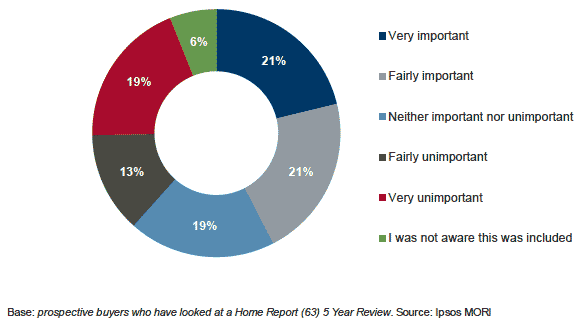
4.53 For those buyers who did use this information, it was largely seen as accurate and sufficient. In the qualitative research, there were no examples of the information being problematic.
4.54 One suggestion that did emerge from the qualitative research was that buyers who used this information would like to be able to use it to search for homes on property search engines.
Practicalities
The process of obtaining a Home Report
4.55 For the most part, buyers and sellers did not report any serious problems when obtaining a Home Report and the process seemed to be straightforward (Figure 4.7).
4.56 Of the 9% of buyers who did face difficulties, the main issues were that selling agents were slow in forwarding the document or that it was not ready. The vast majority (96%) accessed the Home Report free of charge.
Figure 4.7 Difficulty accessing the Home Report
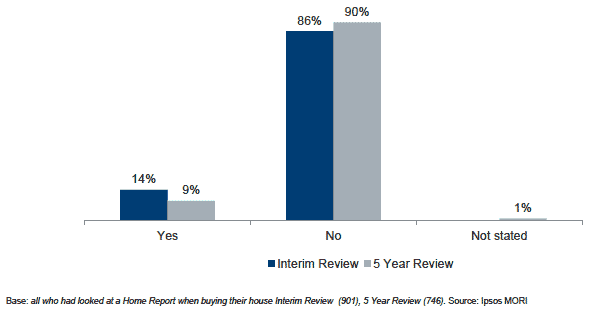
4.57 The majority of sellers commissioned their Home Report through a selling agent, rather than approaching a surveyor directly (84%, compared with 13%, respectively).
4.58 As can be seen in Figure 4.8, the cost of the Home Report varied greatly between sellers. This is to be expected to some extent because the cost of the Home Report can depend on the value of the property. The vast majority paid for the survey upfront in a single payment (84%).
Figure 4.8 Cost of the Home Report
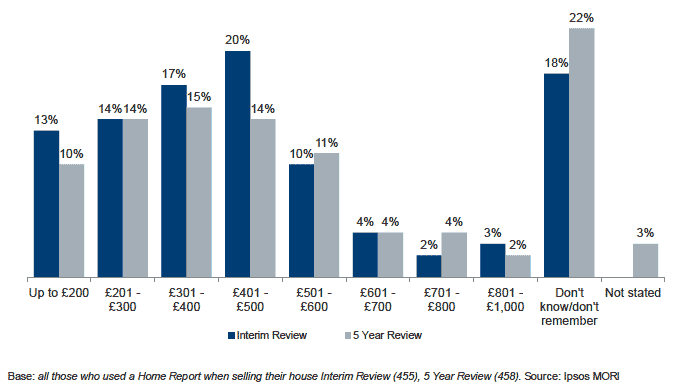
4.59 Industry professionals had less to say about the process than some of the other aspects of the Home Report but selling agents did comment that it had considerably slowed down the process of marketing a property. Whereas in the previous system they could get a property on the market the next day, it now takes 10-14 days to do so. A number of estate agents and surveyors were of the opinion that there was a capacity issue in the market due to surveyors moving jobs or being reassigned in the downturn. Their view was that as the market was now improving and surveying companies were restructuring themselves, it was taking longer for Home Reports to be completed and, therefore, for properties to be marketed. However, other professionals felt that this was actually due to delays during the drafting process, for example waiting for the seller to complete the property questionnaire, or the seller asking for revisions on the report.
4.60 Industry professionals also suggested that the additional upfront cost of the Home Report could put sellers off entering the property market, particularly if they just want to 'test the water'. However, only 7% of prospective sellers said that the cost of the Home Report would 'deter them a lot' from putting their home up for sale.
4.61 The combination of these two issues - that it takes more time to put a property on the market and there are additional upfront costs- caused concern, again among some housing industry professionals, that this could lead to an increase in home repossessions. It was suggested that those in financial difficulty may not be able to afford to put their home on the market, or would not sell it quickly enough to prevent repossession. However, some stakeholders disputed this as the trend has been for mortgage lenders to leave those with financial difficulties in situ.
4.62 The latter view is supported by data on repossessions in Scotland, the number of which have fallen over the last five years (Figure 4.9).
Figure 4.9 Number of repossessions in Scotland, 2008/09-2012/13
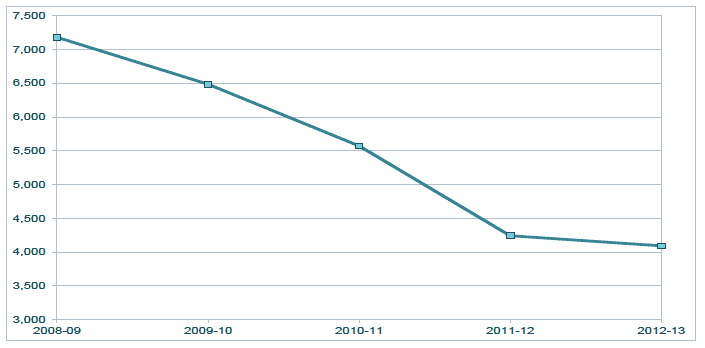
Source: Scottish Government, Civil Law Statistics
Complaints
4.63 Only 5% of buyers or sellers had made a complaint about the Home Report. This supports the key finding that, broadly speaking, consumers are satisfied with the Home Report.
4.64 Feedback from consumer advocacy stakeholders reinforced this finding as they reported receiving relatively few complaints about the Home Report compared with other aspects of the property buying process (most notably, issues around mortgage financing).
4.65 Stakeholders felt that problems of compliance with the Home Report were predominantly an issue on the west coast of Scotland, although they were not thought to be widespread and related to a number of specific businesses. The compliance issues that did arise were around marketing properties before a Home Report was obtained. Specific examples include using 'Coming Soon' signs to advertise properties and marketing properties with a 'draft Home Report' that is subject to change.
4.66 While stakeholders held the view that up until recently there was a tendency for auction houses to avoid getting a Home Report for properties in their brochures, they said that this was no longer a major problem.
Impact on consumers
4.67 Feedback from housing industry professionals and stakeholders tended to focus on problems with the Home Report and possible improvements. However, there were many positive impacts for the consumer.
4.68 Just over half of buyers (54%) reported that the Home Report had increased their confidence in the buying process (Figure 4.10). The qualitative research suggested that this was due to them having a greater amount of information readily available at the start of the buying process. National stakeholders highlighted the importance the Home Report has had in ensuring buyers are fully informed before purchasing a property. They believed that buyers are now more knowledgeable than they were in the past as previously the majority of buyers only commissioned a Scheme One mortgage valuation rather than an actual survey.
Figure 4.10 Confidence in the buying/selling process
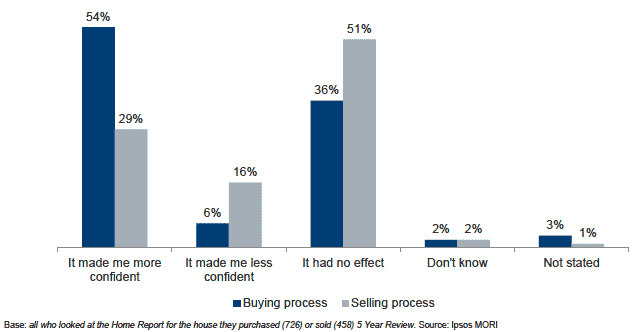
4.69 Findings from the qualitative research indicated that both buyers and sellers felt confident in the valuation provided by the Home Report. However, when asked if the Home Report had affected their confidence in the buying/selling process, buyers were more likely to say that it had increased their confidence than sellers (54% of buyers, compared with 29% of sellers).
4.70 Sellers reported that the Home Report helped them to identify necessary physical improvements or provided a 'reality check' and a 'second opinion' about the condition of the property. Even if they were aware that work needed to be done, it reassured them of their property's condition and provided a point of reference when showing potential buyers around their property.
4.71 Some national stakeholders mentioned that the Home Report made the property market fairer as information was provided upfront and all buyers were on an 'even playing field'. S4takeholders thought this was particularly beneficial for first-time buyers who were unfamiliar with the market and those at the lower end of the market who do not have a great deal of money to spare on paying for multiple surveys.
4.72 However, while this means that the transparency of the process had increased in some ways - i.e. every potential buyer has access to the same information - in other ways tr4ansparency was seen to have reduced.
4.73 Industry professionals suggested that a lack of transparency exists because the buyer has no control over the survey, meaning that they have no way of knowing how it was commissioned or what kind of relationship exists between the surveyor and the selling agent.
4.74 For the most part, this meant that consumers were not aware of any less respectable business practices that could arise because of the conflict of interest between sellers/surveyors/buyers (see section 4.33 and 4.39 for more details). While professionals thought instances of serious misconduct were not prevalent, they highlighted that buyers would not be able to see such business practices when they did occur.
Market performance since the Home Report was introduced
4.75 So far, the commentary in this section has focussed on the impact of the Home Report on both consumers and on the wider housing industry. In the remainder of the section consideration is given to the housing market data in Scotland since the Home Report was introduced. This helps to understand the context in which the Home Report has operated and allows some conclusions to be drawn about the impact its introduction may have had on the market compared to other factors, such as the prevailing economic conditions.
4.76 A key indicator of housing market performance is market value, i.e. the total value of all property sold, also known as turnover. This combines both transactions and prices (Figure 4.11).
4.77 The housing market grew rapidly between 2004 and 2008. This was at the end of the period that economists refer to as 'The Great Moderation', when the UK (including Scotland) experienced steady and consistent levels of economic growth. This positively impacted on employment, earnings and consumer sentiment. Combined with an expansionist lending policy, this led to the first housing 'bubble' in Scotland, with average house prices doubling between 2001 and 2007. Transactions (and turnover) reached record levels in Q3 2007.
4.78 However, the market began to change from this point. The 'credit crunch' began in the summer of 2007 and a number of financial crises began to gather momentum from this time. This impacted on lending volumes and, as a consequence, house sales.
4.79 However, it was the collapse of Lehman Brothers in September 2008 that precipitated an international financial crisis and the longest recession for nearly a century. It was from this time that most economic indicators began to move downwards quite rapidly, including housing market turnover. The Home Report was introduced in Scotland just as this sharp market correction had occurred.
Figure 4.11 Economic timeline versus total market value of residential property sold in Scotland, 2004-14
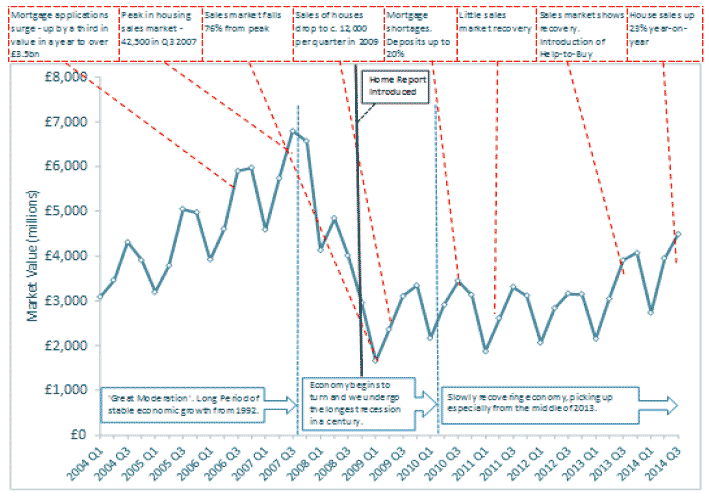
Source: Rettie & Co. and Registers of Scotland
4.81 The changes in economic and housing market conditions since late 2008 suggest that care should be taken in attributing changes in market value to the Home Report.
4.82 The evidence suggests that impacts on house prices and transaction levels have been as a result of wider economic and housing market conditions. For example, transaction levels have followed a similar path for new build properties (where a Home Report is not required) and for second hand properties (where, in most cases, a Home Report is required); this is shown in Figure 4.12.
Figure 4.12 Index of quarterly sales volumes - Scotland, 2002-14 (2002 = 100)
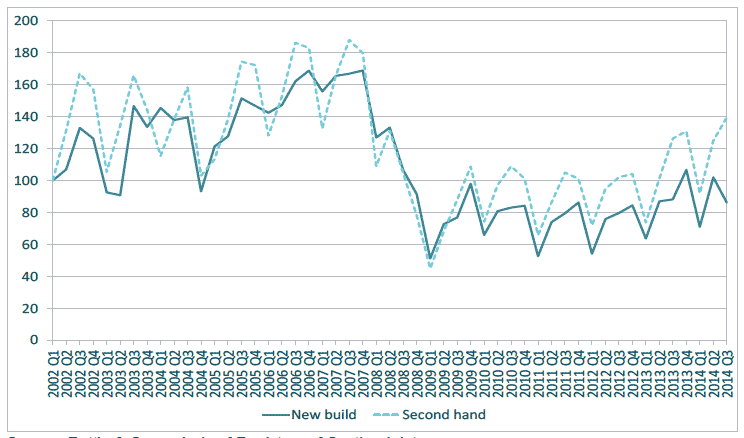
Source: Rettie & Co analysis of Registers of Scotland data
4.83 In addition, house prices largely stabilised in nominal terms after the recession, but this is unlikely to be due to the Home Report as this happened for both new build and second hand properties (Figure 4.13).
Figure 4.13 Average quarterly sales prices, Scotland, 2004-14
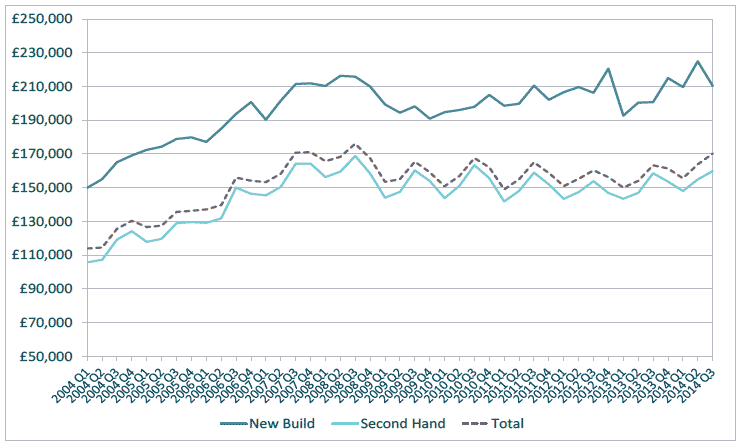
Source: Rettie & Co analysis of Registers of Scotland data
4.84 It is also the case that there were similar price patterns across UK regions post-recession (where there is no Home Report), with the exception of London, where prices soared due to strong localised demand drivers (see Appendix J).
4.85 Wider market changes also meant that property took longer to sell in the downturn, although this is now improving (see Figure 4.14).
Figure 4.14 Average number of days of property on the market in selected Scottish areas, 2008-14
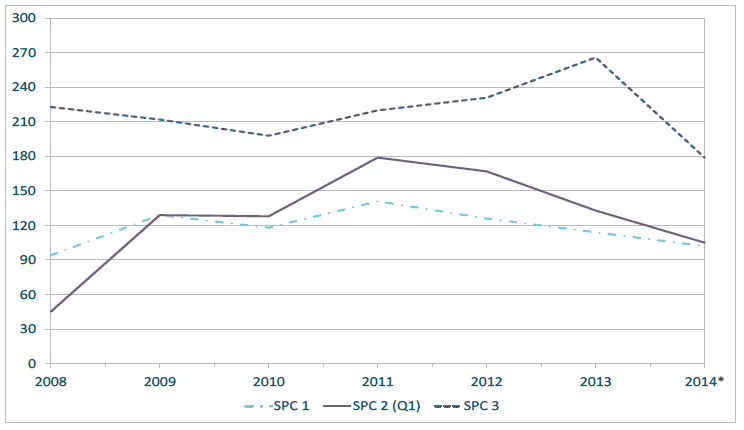
Source: Solicitor Property Centres
4.86 In the majority of SPC areas for which we have data, it is also interesting to note that, in the downturn, there was a move towards properties selling below Home Report valuation, but this has changed as the market has improved since mid-2013. A larger proportion of property is now being sold above Home Report valuation (see Figure 4.15). This is the case for both urban and rural SPC areas, although this data only represents a small number of Scottish areas.
Figure 4.15 Percentage of properties selling above Home Report valuation in Scottish areas
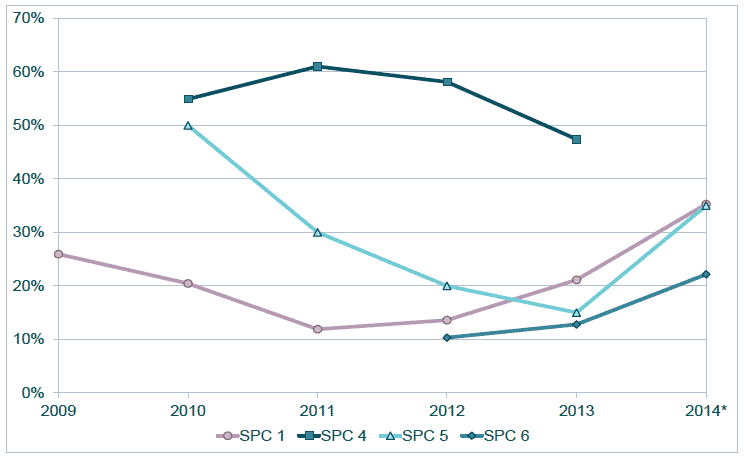
Source: Solicitors Property Centres
4.87 For one SPC area, we received data on the percentage of sales that occurred below and above the asking price. In this area, the proportion of sales fetching well above the asking price (10% or more) has substantially declined since 2008, from 55% of sales to just 8% of sales (Table 4.3).
Table 4.3 Percentage of properties selling above and below asking price in an SPC area
| Sales Price Against Asking Price | ||||||
|---|---|---|---|---|---|---|
| 2008 | 2009 | 2010 | 2011 | 2012 | 2013 | |
| 5% or More Below | 14.8% | 24.9% | 21.9% | 33.3% | 35.4% | 21.4% |
| Within 1% | 13.9% | 24.1% | 27.4% | 31.0% | 30.6% | 25.3% |
| 1-10% Over | 16.7% | 43.5% | 44.2% | 32.7% | 31.9% | 45.7% |
| 10-20% Over | 25.9% | 6.4% | 5.3% | 2.2% | 1.5% | 6.9% |
| 20% or More Over | 28.7% | 1.0% | 1.0% | 0.6% | 0.5% | 0.7% |
Source: Solicitors Property Centre
4.88 Another SPC area provided data on the average premium paid on properties marketed at Offers Over in their area on a quarterly basis from 2008. We can see here the sharp decline on premiums being achieved since early 2008, although this change appears to have been underway before the Home Report was introduced (Figure 4.16).
Figure 4.16 Average premium on properties marketed as Offers Over in an SPC area, 2008-14
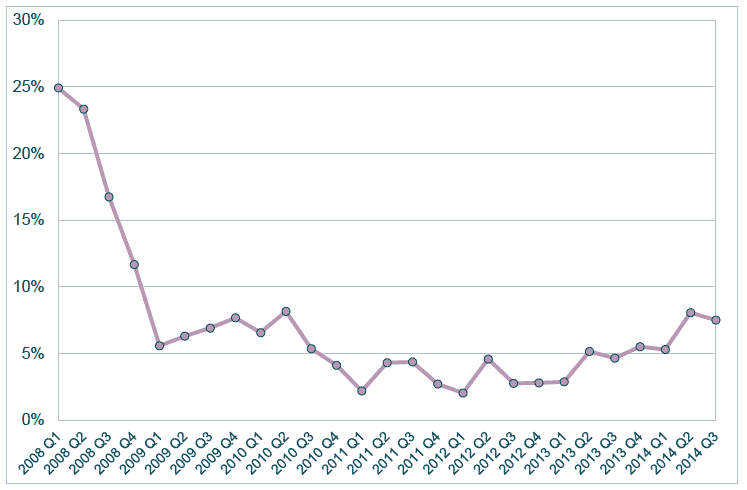
4.89 These are only two areas and the results may have also been a result of wider market changes rather than the Home Report, but this does provide some evidence that artificially low prices are now not the problem they once where (and ties in with the evidence from industry professionals).
Contact
Email: Ruth Whatling
There is a problem
Thanks for your feedback